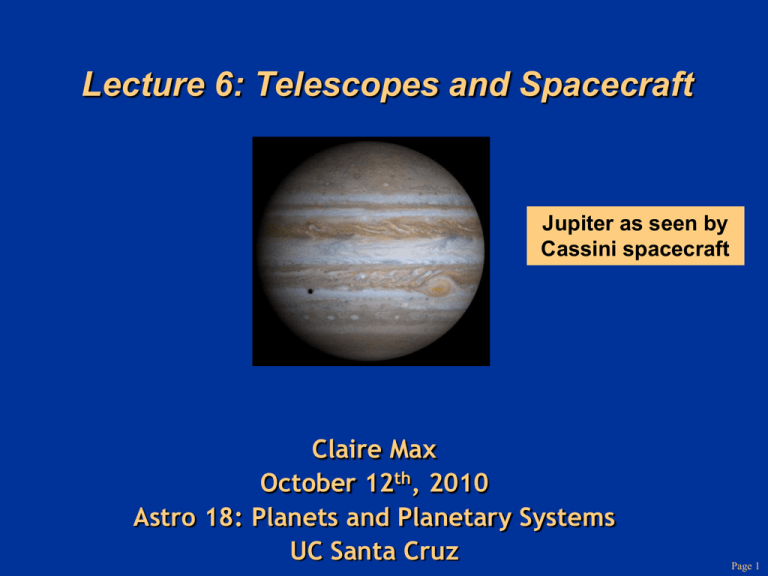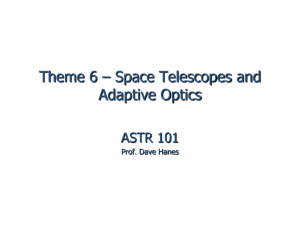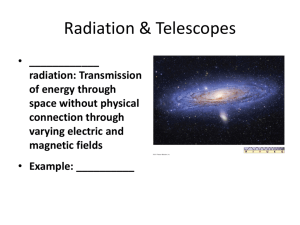Lecture6.v1 - Lick Observatory
advertisement

Lecture 6: Telescopes and Spacecraft Jupiter as seen by Cassini spacecraft Claire Max October 12th, 2010 Astro 18: Planets and Planetary Systems UC Santa Cruz Page 1 Homework • I fell behind • I will post homework shortly • It will be due a week from today, rather than this Thursday as I had promised • Sorry! Page 2 Page 3 Lick Observatory Field Trip Nov 12 • There will a field trip to Lick Observatory's Mount Hamilton station on Fri Nov 12, 2010. • The trip is optional, and open only to students in ASTR 1, 18, and 70. We can only accommodate the first 40 students who sign up. • Sign up in person with Cathy Clausen in the Astronomy department office (ISB 211) and pay her $5 to reserve your spot for the trip (no refunds if you don't show up). • We will arrange transportation in UCSC vans. We will leave campus at 1:30PM and you should be back in your rooms by midnight. • See class website for details. Page 4 Topics for this lecture • Finishing up last Thursday’s lecture on light and its interaction with matter – Emission and absorption of light by atoms – Concept of a spectrum – Blackbody emission: how does shape of spectrum depend on temperature of the emitting body? • Telescopes on the ground and in space Please remind me to take a break at 12:45 pm! Page 5 Emission of light by an atom Page 6 Absorption of light by an atom © Nick Strobel Page 7 Continuous Spectrum • The spectrum of a common (incandescent) light bulb spans all visible wavelengths, without interruption. Page 8 Emission Line Spectrum • A thin or low-density cloud of gas emits light only at specific wavelengths that depend on its composition and temperature, producing a spectrum with bright emission lines. Page 9 Absorption Line Spectrum • A cloud of gas between us and a light bulb can absorb light of specific wavelengths, leaving dark absorption lines in the spectrum. Page 10 Chemical Fingerprints • Each type of atom has a unique spectral fingerprint (a discrete set of spectral lines at specific wavelengths) Page 11 When do you see absorption lines? emission lines? © Nick Strobel Page 12 Thermal Radiation • Nearly all large or dense objects emit thermal radiation, including stars, planets, you. • Sometimes called “blackbody radiation” • An object’s thermal radiation spectrum depends on only one property: its temperature. Page 13 Properties of Thermal Radiation 1. Hotter objects emit more light/area at all frequencies. 2. Hotter objects emit photons with a higher average energy (shorter wavelength). Page 14 Bluer color emitted light means hotter temperature of the matter Wien's law peak 2.9 10 nm T (Kelvin) 6 © Nick Strobel Page 15 Total flux emitted increases with temperature T flux F T 4 joules per sec per m 2 of area Stefan Boltzmann constant 5.67 10 8 joules sec1 m2 K 4 Page 16 Some things you can learn from a spectrum • Temperature and density of matter at the light source • Ionization state • Chemical composition – Example: ozone as sign of life on Earth • Presence of specific minerals – Example: Lunar Prospector spacecraft, ice on moon • Structure of atmosphere – Example: Neptune clouds, height of cloud layers • Velocities of the material emitting or absorbing the light Page 17 Topics for this lecture • Finishing up last Thursday’s lecture on light and its interaction with matter ✓ • Telescopes and spacecraft: how we learn about the planets – Lenses – Cameras and the eye – Telescope basics (optical, x-ray, radio telescopes) – Blurring due to atmospheric turbulence; adaptive optics – Airborne telescopes – Spacecraft Page 18 Telescopes: Main Points • Telescopes gather light and focus it – Larger telescopes gather more light – Telescopes can gather “light” at radio, infrared, visible, ultraviolet, x-ray, γ-ray wavelengths • Telescopes can be on ground, on planes, in space • If Earth’s atmosphere weren’t turbulent, larger groundbased telescopes would give higher spatial resolution – Adaptive optics can correct for blurring due to turbulence Every new telescope technology has resulted in major new discoveries and surprises Page 19 What are the two most important properties of a telescope? 1. Light-collecting area: Telescopes with a larger collecting area can gather a greater amount of light in a shorter time. 2. Angular resolution: Telescopes that are larger are capable of taking images with greater detail. Page 20 Telescopes gather light and focus it Refracting telescope • Telescope as a “giant eye” – You can gather more light with a telescope, hence see fainter objects Page 21 Amount of light gathered is proportional to area of lens • Why area? versus • “Size” of telescope is usually described by diameter d of its primary lens or mirror • Collecting area of lens or mirror = r2 = (d/2)2 Page 22 Light-gathering power • Light-gathering power area = (d/2)2 • Eye: – At night, pupil diameter ~ 7 mm, Area ~ 0.4 cm2 • Keck Telescope: – d = 10 meters = 1000 cm, Area = 7.85 x 105 cm2 – Light gathering power is 1.96 million times that of the eye! Page 23 Refracting telescopes focus light using “refraction” • Speed of light is constant in a vacuum • But when light interacts with matter, it usually slows down a tiny bit • This makes “rays” of light bend at interfaces Page 24 Refraction animation • http://www.launc.tased.edu.au/online/sciences/physics/refrac.html Page 25 A lens takes advantage of the bending of light to focus rays Focus – to bend all light waves coming from the same direction to a single point Page 26 Parts of the Human Eye • pupil – allows light to enter the eye • lens – focuses light to create an image • retina – detects the light and generates signals which are sent to the brain Camera works the same way: the shutter acts like the pupil and the film acts like the retina! Page 27 The lens in our eyes focuses light on the retina Note that images are upside down! Our brains compensate! Page 28 Camera lens focuses light on film or CCD detector Upside down Page 29 What have we learned? • How does your eye form an image? – It uses refraction to bend parallel light rays so that they form an image. – The image is in focus if the focal plane is at the retina. • How do we record images? – Cameras focus light like your eye and record the image with a detector. – The detectors (CCDs) in digital cameras are like those used on modern telescopes Page 30 What are the two basic designs of telescopes? • Refracting telescope: Focuses light with lenses • Reflecting telescope: Focuses light with mirrors Page 31 Cartoon of refracting telescope Page 32 Telescopes can use mirrors instead of lenses to gather and focus light • For practical reasons, can’t make lenses bigger than ~ 1 meter • Can make mirrors much larger than this – Largest single telescope mirrors today are about 8.5 m • Old-fashioned reflecting telescope: – Observer actually sat in “cage” and looked downward Page 33 Mount Palomar (near San Diego): Prime focus cage and an inhabitant • "NOTE: Smoking and drinking are not permitted in the prime focus cage" (On web page of Anglo Australian Telescope) • Until the 1970’s, women weren’t permitted either! Looking down the telescope tube from the top. Mirror is at the bottom. Page 34 More photos of Prime Focus Cage: things really have gotten better! Page 35 Designs for Reflecting Telescopes Page 36 Most of today’s reflecting telescopes use Cassegrain design • Light enters from top • Bounces off primary mirror • Bounces off secondary mirror • Goes through hole in primary mirror to focus Page 37 Examples of real telescopes • Backyard telescope: – 3.8” diameter refracting lens – Costs ~ $300 at Amazon.com – Completely computerized: it will find the planets and galaxies for you Page 38 Largest optical telescopes in world • Twin Keck Telescopes on top of Mauna Kea volcano in Hawaii Page 39 36 hexagonal segments make up the full Keck mirror Page 40 Cleaning the Keck’s 36 segments Page 41 One Keck segment (in storage) Page 42 Future plans are even more ambitious Thirty Meter Telescope Keck Telescope Page 43 Future plans are even more ambitious People! Page 44 Concept of angular resolution Car Lights Angular resolution • The ability to separate two objects. • The angle between two objects decreases as your distance to them increases. • The smallest angle at which you can distinguish two objects is your angular resolution. Page 45 How big is one "arc second" of angular separation? • A full circle (on the sky) contains 360 degrees or 2 radians – Each degree is 60 arc minutes – Each arc minute is 60 arc seconds 1 arc min 1 degree 2 radians 1 arc sec 60 arc sec 60 arc min 360 degrees 2 radians = 4.8 10 -6 radian = 4.8 rad 5 rad 60 60 360 or 1 rad 0.2 arc sec Page 46 What does it mean for an object to “subtend an angle ” ? Your eye Angle Θ A distant object Θ is the apparent angular size of the object Page 47 “Small angle formula” • sin Θ ~ Θ if Θ is << 1 radian • s = d sin Θ ~ d Θ θ s d • Example: how many arc sec does a dime subtend if it is located 2 km away? A dime is about 1 cm across, so s 1 cm 1 km 1m 1 1 rad 5 10 radians -6 5 rad = 1 arc sec d 2 km 1000 m 100 cm 2 10 rad Page 48 Concept Question From Earth, planet A subtends an angle of 5 arc sec, and planet B subtends an angle of 10 arc sec. If the radius of planet A equals the radius of planet B, then a) planet A is twice as big as planet B. b) planet A is twice as far as planet B. c) planet A is half as far as planet B. d) planet A and planet B are the same distance. e) planet A is four times as far as planet B. Page 49 What do astronomers do with telescopes? • Imaging: Taking (digital) pictures of the sky • Spectroscopy: Breaking light into spectra • Timing: Measuring how light output varies with time Page 50 Imaging • Filters are placed in front of a camera to allow only certain colors through to the detector • Single color images are then superimposed to form true color images. Page 51 How can we observe invisible light? • A standard satellite dish is just a reflecting telescope for observing radio waves. Page 52 How can we record images of nonvisible light? • Electronic detectors such as CCDs can record light our eyes can't see - Infrared light, ultraviolet light, even x-rays • We can then represent the recorded light with some kind of color coding, to reveal details that would otherwise be invisible to our eyes Page 53 "Crab Nebula" - supernova remnant where a star blew up 1000 yrs ago From above the atmosphere Infra-red light Visible light X-rays Page 54 In principle, larger telescopes should give sharper images • Concept of “diffraction limit” – Smallest angle on sky that a telescope can resolve d radians D where = wavelength of light, D = telescope diameter in the same units as In same units! – Numerically: diffraction limit wavelength of light = 2.5 10 arc seconds diam of telescope 5 Page 55 Image of a point source seen through a circular telescope mirror • At the “diffraction limit”, size of central spot ~ / D Diffraction limit animation Page 56 Example of diffraction limit • Keck Telescope, visible light telescope diameter D = 10 meters wavelength of light diffraction limit = 5000 Angstroms = 5 10 -7 meter 5 10 -7 = 2.5 10 arc seconds = 0.0125 arc second 10 5 • BUT: Turbulence in the Earth’s atmosphere blurs images, so even the largest telescopes can’t “see” better than about 1 arc second – A decrease of a factor of 1 / 0.0125 = 80 in resolution! Page 57 Images of a bright star, Arcturus Lick Observatory, 1 m telescope Long exposure image Short exposure image Diffraction limit of telescope Page 58 Snapshots of turbulence effects, Lick Observatory These are all images of a star, taken with very short exposure times (100 milliseconds) Page 59 How to correct for atmospheric blurring Measure details of blurring from “guide star” near the object you want to observe Calculate (on a computer) the shape to apply to deformable mirror to correct blurring Light from both guide star and astronomical object is reflected from deformable mirror; distortions are removed Page 60 Infra-red images of a star, from Lick Observatory adaptive optics system No adaptive optics With adaptive optics Page 61 Deformable mirror is small mirror behind main mirror of telescope Page 62 Mirror changes its shape because actuators push and pull on it • Actuators are glued to back of thin glass mirror • When you apply a voltage to an actuator, it expands or contracts in length, pushing or pulling on the mirror Page 63 Neptune in infra-red light, Keck Telescope adaptive optics With adaptive optics 2.3 arc sec Without adaptive optics Page 64 Movie of volcanoes on Jupiter’s moon Io, from Keck Telescope adaptive optics Volcanoes are glowing in infrared light Page 66 Concept Question • The Keck Telescope in Hawaii has a diameter of 10 m, compared with 5 m for the Palomar Telescope in California. The light gathering power of Keck is larger by a factor of a) 2 • b) 4 c) 15 d) 50 By what factor is Keck’s angular resolution better than that of Palomar, assuming that both are using their adaptive optics systems? a) 2 b) 4 c) 15 d) 50 Page 67 Reflecting telescopes work fine at radio wavelengths too • The radio telescope at Green Bank, NC Page 68 Largest radio telescope fills a whole valley in Puerto Rico Arecibo Observatory Page 69 Spectroscopy Light from a star enters • A spectrograph separates the Diffraction different grating breaks wavelengths of light into light before they spectrum hit the detector Detector records spectrum Page 70 Spectroscopy and the effect of spectral resolution • Graphing relative brightness of light at each wavelength shows the details in a spectrum • Higher spectral resolution = more detail as a function of wavelength Page 71 Timing • A light curve represents a series of brightness measurements made over a period of time Page 72 Timing: Dust devils on Mars seen from Spirit Rover Page 73 Want to buy your own telescope? • Buy binoculars first (e.g. 7x35) - you get much more for the same money. • Ignore magnification (sales pitch!) • Notice: aperture size, optical quality, weight and portability. • Product reviews: Astronomy, Sky & Telescope, Mercury Magazines. Also amateur astronomy clubs. Page 74 Why do we need telescopes in space? Page 75 Why do we need telescopes in space? a) Some wavelengths of light don’t get through the Earth’s atmosphere • Gamma-rays, x-rays, far ultraviolet, long infrared wavelengths b) Going to space is a way to overcome blurring due to turbulence in Earth’s atmosphere c) Planetary exploration: spacecraft can actually go to the planets, get close-up information Page 76 Depth of light penetration into atmosphere at different wavelengths Page 77 X-ray mirrors also concentrate light and bring it to a focus • X-ray mirrors Page 78 Chandra spacecraft: x-ray telescope Page 79 Types of space missions • Earth orbiters – Hubble and Chandra space telescopes • Planetary fly-bys – Mercury, Venus, Mars, Jupiter, Saturn, Uranus, Neptune so far – New Horizons flyby of Pluto arrives July 14 2015 • Planetary orbiters – Venus, Mars, Jupiter, Saturn so far. – Soon: Mercury Messenger (March 2011) • Probes and landers – – – – Mars rovers: Spirit and Opportunity Mars landers: e.g. Phoenix Probes sent from orbiters of Venus, Mars, Jupiter Titan lander (Huygens probe from Cassini spacecraft) Page 80 Space missions carry telescopes, other instruments as well • Typically planetary fly-bys and orbiters carry small telescopes – If you are close, you don’t need super-good angular resolution • Other instruments: – Particle analyzers, radio antennae, spectrographs, laser altimeters, dust detectors, ..... – Mars rovers: probes to get rock samples and analyze them Page 81 Hubble Space Telescope: clearer vision above atmospheric turbulence Hubble can see UV light that doesn’t penetrate through atmosphere Page 82 Example of robotic planet exploration: Galileo mission to Jupiter (Artist's conception) Page 83 Spirit Rover on Mars Page 84 Concept Question • You are trying to decide whether to observe a new comet from a 10m telescope on the ground (without adaptive optics), or from the Hubble Space Telescope (diameter 2.4m). • Which of the following would be better from the ground, and which from space a) Ability to make images in ultraviolet light b) Spatial resolution of images in infrared light c) Ability to record images of a very faint (distant) comet Page 85 Telescopes: The Main Points • Telescopes gather light and focus it • Telescopes can be on ground, on planes, in space • If Earth’s atmosphere weren’t turbulent, larger telescopes would give higher spatial resolution – Adaptive optics can correct for blurring due to turbulence • Every new telescope technology has resulted in major new discoveries and surprises Page 86





